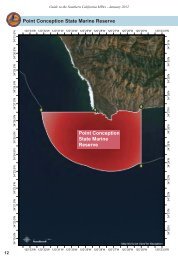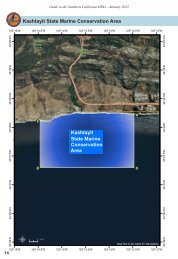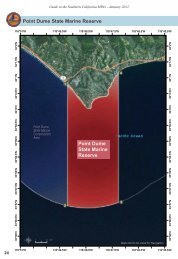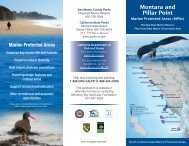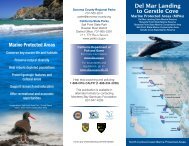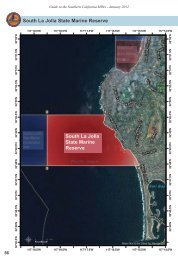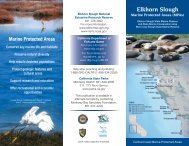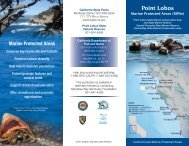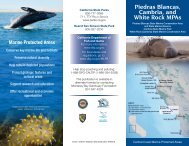Frequently Asked Questions on California’s Marine Protected Areas (MPAs)
CA MPA FAQ PDF - California MPA Educational Resources
CA MPA FAQ PDF - California MPA Educational Resources
Create successful ePaper yourself
Turn your PDF publications into a flip-book with our unique Google optimized e-Paper software.
<str<strong>on</strong>g>Frequently</str<strong>on</strong>g> <str<strong>on</strong>g>Asked</str<strong>on</strong>g> <str<strong>on</strong>g>Questi<strong>on</strong>s</str<strong>on</strong>g> <strong>on</strong> <strong>California’s</strong> <strong>Marine</strong> <strong>Protected</strong><br />
<strong>Areas</strong> (<strong>MPAs</strong>)<br />
What are marine protected areas, or <strong>MPAs</strong>?<br />
Like parks protect wildlife and habitats <strong>on</strong> land, marine protected areas (<strong>MPAs</strong>) protect and restore<br />
wildlife and habitats al<strong>on</strong>g the coast of California. <strong>California’s</strong> marine protected areas come in many<br />
“flavors”; the size and level of protecti<strong>on</strong>, including fishing restricti<strong>on</strong>s, can vary from <strong>on</strong>e area to the<br />
next. Also called underwater parks, they’re designed to protect plants and animals within an entire<br />
ecosystem, rather than protecting just a single species. In December 2012, California became an<br />
internati<strong>on</strong>al leader in ocean protecti<strong>on</strong> by completing the United States’ first statewide network of<br />
marine protected areas that are designed to ensure healthy, vibrant ocean life for generati<strong>on</strong>s to come.<br />
Why do we need marine protected areas?<br />
<strong>California’s</strong> coastal waters are some of the richest in the world, but real problems lurk below the ocean's<br />
surface. Ninety percent of the big fish that existed in the 1950s are missing and three-fourths of<br />
<strong>California’s</strong> kelp forest has disappeared since the 1960s 1 . Meanwhile, California fishing communities are<br />
still recovering from the collapse of the west coast groundfish fishery and the closure of all five<br />
commercial abal<strong>on</strong>e fisheries. In numerous studies worldwide, <strong>MPAs</strong> have proven to boost fish size,<br />
abundance and diversity, and increase the productivity and resilience of the protected area.<br />
How do they protect the entire ocean ecosystem?<br />
<strong>Marine</strong> protected areas safeguard critical ocean habitat, allowing sensitive marine communities such as<br />
rocky reefs and seagrass beds to thrive and recover. These special places also protect biological hotspots<br />
and important foraging grounds. This in turn benefits a range of species including plants like bull kelp,<br />
invertebrates like sea stars, and marine mammals such as seals and otters. As safe havens, underwater<br />
parks offer a home and refuge for big, old, fat, female fish to recover, grow and replenish our oceans.<br />
What can I do in an underwater park?<br />
There are many ways to enjoy <strong>California’s</strong> ocean parks. You can swim, dive, surf, kayak, watch birds and<br />
mammals and simply relax in nature. You can also bring your children to explore marine life in tidepools,<br />
as l<strong>on</strong>g as you take <strong>on</strong>ly photos and leave animals and shells where they are. Or, you can get involved in a<br />
citizen science project and help study wildlife and m<strong>on</strong>itor ocean change, or become a volunteer educator<br />
who teaches visitors about life above and beneath the waves.<br />
Is fishing and the take of marine life allowed?<br />
Fishing and the take of marine life such as shellfish or seaweed is allowed in about half of <strong>California’s</strong><br />
marine protected areas. Each type or kind of marine protected area has different regulati<strong>on</strong>s; inside state<br />
marine parks, sport fishing is encouraged, but commercial fishing is prohibited. In state marine reserves,<br />
fishing is not allowed. It’s best to visit the California Department of Fish and Wildlife website at<br />
www.dfg.ca.gov/mlpa to learn about the specific rules for each marine protected area.<br />
How big are most of the state marine protected areas, and how far out do they extend from shore?<br />
All of <strong>California’s</strong> state marine protected areas are located inside the state water boundaries within three
nautical miles from shore. Their size, shape and locati<strong>on</strong> vary. Some are <strong>on</strong>ly a few hundred meters out<br />
from the shore, and others extend out to the federal waters (three nautical miles). Each was designed as<br />
part of a statewide network, following a set of scientific guidelines.<br />
How do marine protected areas address water polluti<strong>on</strong>?<br />
The <strong>Marine</strong> Life Protecti<strong>on</strong> Act that created the underwater park system in California provides authority<br />
to regulate what is taken out of the ocean; other state and federal laws regulate what goes into the ocean.<br />
For example, <strong>Areas</strong> of Biological Significance, Nati<strong>on</strong>al <strong>Marine</strong> Sanctuaries and Nati<strong>on</strong>al Estuaries<br />
actually do have laws to promote better water quality. Water quality is an issue al<strong>on</strong>g <strong>California’s</strong> coast,<br />
and marine protected areas can boost efforts to reduce polluti<strong>on</strong> by attracting attenti<strong>on</strong> to our coast’s<br />
ecological and ec<strong>on</strong>omic value.<br />
How do the state marine protected areas affect the fishing industry?<br />
California fishermen have suffered ec<strong>on</strong>omic hardships in recent years due to declines in commercially<br />
important fish and inadequate management. For example, landings in the commercial rockfish fishery<br />
declined statewide by 95 percent over the past 25 years 3 . <strong>Marine</strong> protected areas can help restore the<br />
ocean ecosystem, which can improve the sustainability of commercial and recreati<strong>on</strong>al fishing, draw<br />
visitors, and enhance tourism, <strong>California’s</strong> biggest coastal industry.<br />
The central coast <strong>MPAs</strong> have been in place for five years. What changes are you seeing?<br />
Five years is a short period of time for recovery of marine populati<strong>on</strong>s to occur, so recovery is expected to<br />
c<strong>on</strong>tinue over many years. Short-lived species such as oysters or clams can recover quickly, but many<br />
slow-growing species such as rockfish need more than five years to show signs of recovery. Some<br />
researchers, like Mark Carr of the University of California Santa Cruz, have seen some improvements in<br />
fish populati<strong>on</strong>s. Other scientists and fishermen are working together now to measure changes to tell us<br />
how our underwater parks are performing over time.<br />
What are you learning in other areas of California where marine protected areas have been in<br />
place l<strong>on</strong>ger? In <strong>California’s</strong> Channel Islands, where <strong>MPAs</strong> have been in place for 10 years, a 2012 study<br />
found that lobsters were more abundant and larger in protected areas, with over five more legal-sized<br />
lobsters caught per trap <strong>on</strong> average inside the refuges. 2 Recreati<strong>on</strong>al fishing in parts of the islands actually<br />
increased from 2003 to 2008, as did commercial landings for some of the Islands’ largest fisheries, such<br />
as squid, urchin, lobster and crab. There are signs of success from places around the world that<br />
dem<strong>on</strong>strate the many benefits of c<strong>on</strong>servati<strong>on</strong> (see http://californiampas.org/pages/about/success.html).<br />
1<br />
Myers, A., Worm, B. (2003) Rapid worldwide depleti<strong>on</strong> of predatory fish communities. Nature 423(280-283).<br />
2 Kay, M.C., (2012) Effects of marine reserves <strong>on</strong> California spiny lobster are robust and modified by fine-scale<br />
habitat features and distance from reserve borders. <strong>Marine</strong> Ecology Progress Series, April 2012<br />
3<br />
Rockfish resources of the south central California coast: Analysis of the resources from party boat data,<br />
1980-2005. Stephens, J. et al. (2006). CalCOFI Rep., Vol. 47, 2006




